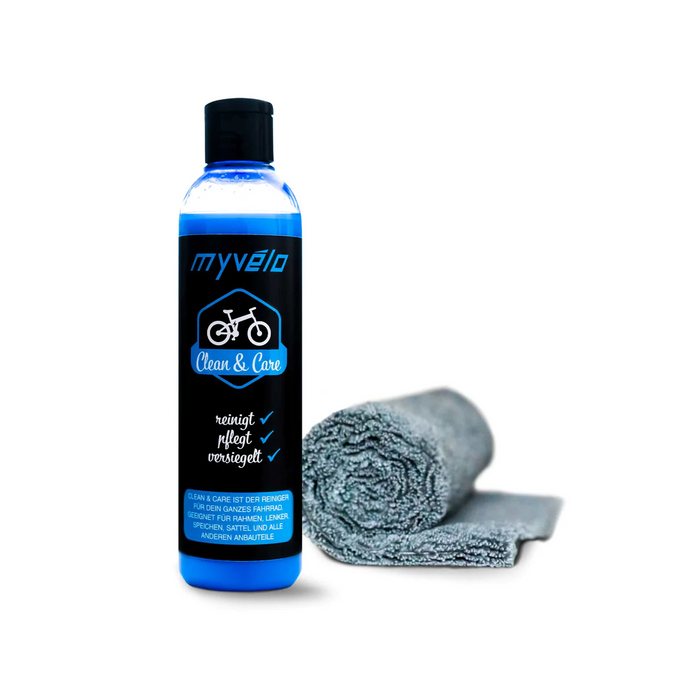
MYVELO Clean and Care bicycle cleaner with polish
incl. FREE shipping & free returns

When it comes to fighting dirt and grime, a steam cleaner may seem like a lifesaver. Its power goes beyond modest water jets and removes any resistance in a matter of seconds. But is it also the hero when it comes to cleaning our beloved bike?
Von Fabian Huber |
3 minutes read time

After all, it's not just about effectively removing dirt. Issues such as rust, material fatigue and the associated risks play an important role. This raises the question: is cleaning the wheel with a steam cleaner a blessing or a curse? Does the minimal amount of time actually offer an advantage, or is it a hasty decision with high risk? The relevance of these points will be examined in detail later on and will provide a deeper insight into the pros and cons.
A steam cleaner, also known as a pressure washer, is an efficient cleaning tool that uses hot water and high pressure to remove stubborn dirt and debris. It involves heating water and detergent in a boiler and spraying them through a nozzle under high pressure. The resulting cloud of steam softens and removes dirt with ease. Steam cleaners are great for a variety of cleaning tasks, from washing cars to cleaning patios to removing moss and algae. Here are the key components of a steam cleaner:
It is important to note that using a steam cleaner requires a certain amount of caution. Due to the high pressure and high temperatures, injuries can occur if handled incorrectly. It is therefore advisable to read the operating instructions carefully before using it for the first time and to familiarize yourself with the safety instructions.
Cleaning with a steam cleaner has several advantages and disadvantages to consider. One of the biggest advantages is that it is quick and efficient.
A steam cleaner can remove stubborn dirt and debris quickly, which is especially useful if you're short on time. It can also remove grease and wax, which can be beneficial when maintaining your bike.
However, the high pressure of the steam cleaner can also cause damage. For example, it can damage the wheels of your bike or remove the paint.
Another disadvantage is that the steam cleaner removes the lubrication from the bike, which can lead to increased wear. In addition, water can penetrate and damage electrical parts, such as a radio circuit.
Likewise, using a steam cleaner can cause rust in bike components, so it is important to dry and re-lubricate the bike thoroughly after cleaning. So consider whether the benefits of quick and efficient cleaning outweigh the potential disadvantages.
Cycling is a popular pastime and an environmentally friendly way of getting around. However, the bike also needs care and cleaning to keep it in good working order. However, you should be careful not to use steam cleaners to clean your bike. Why is that?
A steam cleaner's high pressure can damage the bike's seals and bearings. These are essential to the bike's functionality and can be expensive to repair. In addition, the strong water jet can remove the paint and stickers from your bike.
Instead, it is recommended to clean the bike with a soft sponge and a mild soap solution. Cleaning should be done in the following steps:
Avoid spraying water directly into bearings, derailleurs or brakes. If there is stubborn dirt in these areas, special bicycle cleaners can help.
Overall, manual cleaning with a sponge and brush is the safest way to keep your bike clean and extend its lifespan, so you can enjoy cycling for a long time to come.

Als Rennradfahrer möchte man möglichst ständig besser werden: schneller, ausdauernder und effizienter. Doch was, wenn der Schlüssel zu diesen Zielen nicht nur auf zwei Rädern liegt? Rudern, oft unterschätzt, bietet eine ideale Ergänzung zum Radtraining. Es trainiert nicht nur den ganzen Körper, sondern verbessert auch die Ausdauer, Kraft und Stabilität – entscheidende Faktoren für jeden Radsportler.

Nach einer intensiven Rennrad-Einheit ist die richtige Regeneration entscheidend, um Leistung zu verbessern, Verletzungen zu vermeiden und langfristig Fortschritte zu erzielen. Doch wie sieht eine effektive Erholung aus? Hier bekommst Du die besten Tipps zur optimalen Regeneration nach dem Rennradtraining.

Erfahre, wie Radsport-Ligen aufgebaut sind und weitere Infos zur Organisation im Profi-Radsport!